Effortless Voice Note-Taking on Your iPhone
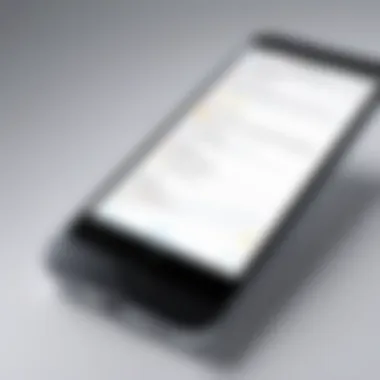
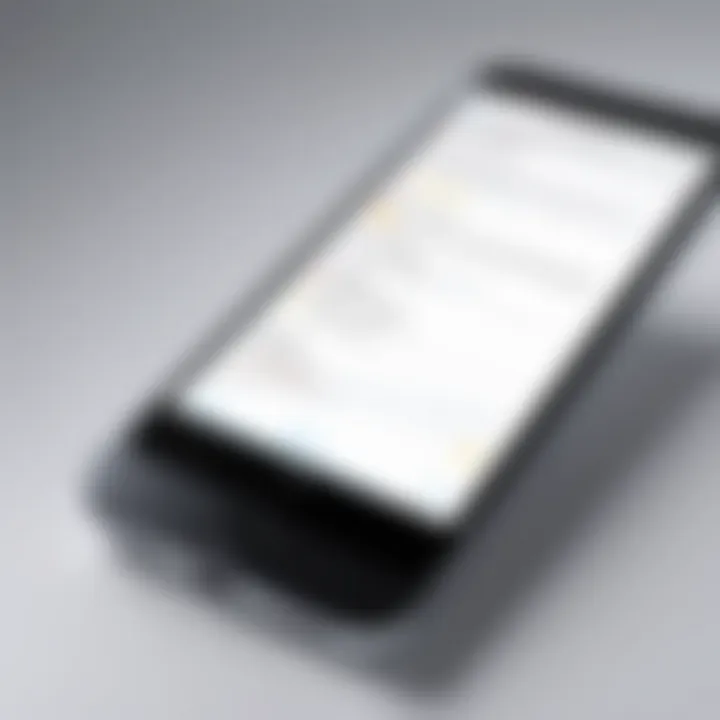
Intro
In the age of rapid digitalization, efficient note-taking has become an essential skill. Utilizing voice technology on your iPhone can significantly enhance this process. This guide aims to demystify the voice-to-text features available on iPhones, helping users to capitalize on its capabilities for effective note-taking. Understanding these features goes beyond mere convenience; it enriches how you capture ideas and thoughts in your daily life.
Overview of the Technology
Voice recognition technology has evolved dramatically over the years. Apple's iPhone comes equipped with integrated voice-to-text features that allow users to create notes hands-free. This technology relies on advanced algorithms that interpret spoken language into written text accurately.
Key specifications include:
- Dictation capabilities: Users can dictate notes in real-time. The iPhone's software captures speech and converts it into text almost instantaneously.
- Language support: Apple's technology supports multiple languages, catering to a global audience. This broadens usability for non-native English speakers.
Unique selling points encompass:
- Integration with apps: The voice note-taking feature seamlessly integrates with applications like Notes, Mail, and Messages. This allows a smooth transition between creating notes and sharing or organizing them.
- User-friendly interface: The interface for dictating notes is intuitive. Users can easily toggle voice recognition on and off, making it simple to use in various environments.
Design and Build Quality
Apple's emphasis on design extends to its note-taking technology. The materials and ergonomics involved in device construction optimize user experience. While the focus here is on voice functionality, it's essential to understand how the build quality of the iPhone supports overall usability.
Materials used in the iPhone enhance durability and performance. The premium build not only feels substantial but also accommodates advanced microphone arrays that improve sound capture quality.
In terms of ergonomics and usability:
- Microphone placement: The design ensures optimal microphone positioning, allowing for clearer voice recognition even in noisy environments.
- Accessibility features: Voice features come with various accessibility options. This caters to users who rely heavily on voice commands, ensuring that everyone can benefit from the technology.
"The integration of voice recognition in mobile devices has changed the way we capture and organize information, making processes faster and more efficient."
As we delve deeper into the functionalities of voice note-taking on iPhone, we will cover settings adjustments, app recommendations, and other critical information. Each section will illuminate best practices that enhance the user experience in practical and meaningful ways.
Preamble to Voice Note-Taking
In today’s fast-paced digital age, effective note-taking can dramatically enhance productivity. Voice note-taking allows users to capture thoughts hands-free while multitasking or on the go. This method not only simplifies the note-taking process but also offers a convenient way to document ideas quickly. For many individuals, leveraging voice technology transforms how they approach capturing information, particularly in a world where time is a limited resource.
Understanding the Need for Voice Notes
Voice notes serve a critical role for individuals who often find themselves overwhelmed by written notes or typing. The immediacy of speaking into a device eliminates the friction of switching tasks or typing out lengthy entries. They are especially beneficial for professionals in fast-paced environments, students during lectures, or anyone needing to jot down ideas spontaneously. Voice notes allow for richer context too, as the tone and emphasis can convey meaning that text may not fully capture.
Advantages of Using Voice Notes
Using voice notes comes with several advantages. First, they enable efficient time management. Instead of taking several minutes to write notes out, users can record their thoughts in real time – this is particularly advantageous in situations like meetings or brainstorming sessions.
Additionally, voice notes improve accessibility for many users. People with writing difficulties or those who find typing cumbersome can express thoughts effortlessly. The ability to use voice recognition features built into devices, such as those found on the iPhone, adds to this accessibility.
Lastly, voice notes simplify organization. Most applications categorize and store audio recordings systematically. This way, users can easily search for and retrieve specific recordings later on.
In summary, voice note-taking presents a modern alternative to traditional notes. Recognizing its necessity and advantages is key for those seeking to enhance their efficiency and productivity in note-taking.
Setting Up Your iPhone for Voice Notes
Setting up your iPhone for voice notes is an essential step in streamlining your note-taking process. Proper configuration ensures that you can easily access the voice recognition features and maximize their potential. This setup not only enhances user experience but also improves accuracy when converting voice to text. It is important to recognize that without the right settings, you might face hurdles that could diminish the utility of voice note-taking.
Enabling Voice Recognition Features
To begin with, you must enable voice recognition features on your iPhone. This functionality is built into iOS and allows for seamless dictation. To activate these features, navigate to the Settings app. Once there, go to "General" and then select "Keyboard." Here, you will find an option for "Enable Dictation." By toggling this on, you allow your device to listen to and transcribe your spoken words.
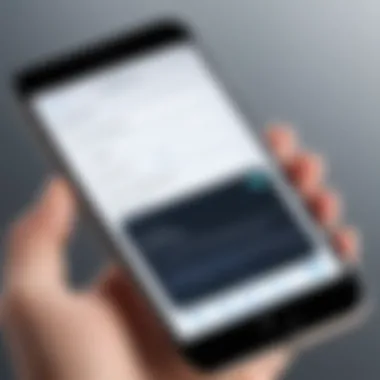

Voice recognition is not just about speech-to-text capabilities; it also relies on the Apple servers to enhance accuracy. Therefore, a stable internet connection may improve performance. Additionally, Apple's device learns from your usage patterns over time, further tuning its recognition capabilities. This iterative learning process enhances its performance with your unique speech patterns.
Configuring Accessibility Options
In addition to enabling voice recognition, configuring accessibility options can also benefit users who rely heavily on voice note-taking. Accessibility features can be found in the Settings under the "Accessibility" section. Here, you can tailor various options to fit your needs.
One useful setting is "Voice Control." By enabling Voice Control, you gain the ability to navigate your iPhone using just your voice. This is especially advantageous for note-taking, as it allows you to create and edit notes hands-free. Moreover, you can set up custom commands if needed, making it easy to set your device to respond specific ways.
Furthermore, you can adjust the verbosity of spoken feedback, which provides clarity when commands are executed. This reduces the ambiguity often present in sound-based interactions. By carefully configuring both voice recognition and accessibility features, your iPhone transforms into a powerful tool for efficient note-taking.
Using Siri for Note-Taking
Using Siri for note-taking can significantly enhance your productivity on the iPhone. This built-in voice assistant allows for hands-free operation, enabling you to take notes wherever you are. The benefits of utilizing Siri include quick access, ease of use, and improved efficiency when compared to traditional typing methods. This section explores the essential aspects of using Siri, focusing on activation, effective voice commands, and editing capabilities.
Activating Siri for Notes
To start using Siri for taking notes, you first need to activate the feature. Follow these simple steps:
- Enable Siri: Go to the Settings app on your iPhone, tap on "Siri & Search" and toggle the options for "Listen for 'Hey Siri'" or "Press Side Button for Siri" based on your preference.
- Choose Language: Ensure that Siri is set to the language you are comfortable with, which will enhance the accuracy of voice recognition.
- Test Activation: Simply say "Hey Siri" or press the side button. Siri confirmation sounds will assure you it is active.
Once activated, you can effortlessly ask Siri to create a note anytime.
Voice Commands for Creating Notes
Siri’s effectiveness is rooted in its ability to understand and process voice commands. When creating notes, consider using specific commands for clarity. Here are a few effective voice commands:
- Create a New Note: Say "Create a new note" to initiate.
- Provide Content: After the prompt, articulate your thoughts clearly. For instance, "Make a note of my meeting at 3 PM" will capture that information accurately.
- Add Details: You can also instruct Siri to add more details, e.g., "Add to my note: bring the presentation slides."
This seamless process allows for quick documentation without the need for manual input.
Editing Notes with Siri
Editing notes through Siri is just as user-friendly and efficient. To modify existing notes, use the following commands:
- Open Note: Bully instruct Siri with "Open my note from last meeting" or specify the note's title.
- Make Changes: Once the note is open, you can say, "Change '3 PM' to 4 PM" for amendments.
- Delete Sections: If you need to remove content, simply say, "Delete the last sentence."
Utilizing these commands allows you to maintain fluency in note updates, ensuring that your notes evolve alongside your thoughts and plans.
Overall, employing Siri for note-taking on your iPhone can transform the way you document and retrieve information, leading to more organized and accessible notes.
Using the Notes App for Voice Recognition
The Notes app on iPhone is one of the most effective tools for voice recognition and note-taking. Its integration with the iOS operating system allows for easy access to note-taking capabilities directly from your device. This feature enhances productivity as users can quickly and efficiently jot down thoughts or ideas without the need for physical input. By leveraging this app, you can significantly streamline your workflow and maintain better organization of your thoughts.
Launching the Notes App
To get started with voice note-taking, you first need to launch the Notes app. This can be done in a few simple steps. On your iPhone, locate the Notes app icon on your home screen. It's typically a yellow notepad with a pencil icon. Tap on it to open.
Once the app is open, you will be greeted by a blank canvas or a list of previously created notes. To create a new note, look for the icon that resembles a pencil on paper, usually found in the bottom right corner. Tap this icon to begin. This action sets the stage for you to use voice recognition effectively.
Dictation Functionality in Notes
The dictation feature within the Notes app serves as a remarkable tool for converting spoken words into text. Once you have a new note open, the microphone icon on the keyboard will appear. Tapping on this icon activates the dictation mode, allowing you to speak naturally. The Notes app will transcribe your speech in real-time.
When dictating, it is crucial to articulate your words clearly. Here are some tips to ensure optimal use of this functionality:
- Speak clearly and at a moderate pace.
This ensures that the app captures your words accurately. - Use punctuation marks verbally.
Words like "comma" and "period" help in structuring your notes correctly. - Review and edit your notes after dictation.
Even with the technology’s advancements, some errors may still occur, requiring adjustments.
By mastering the dictation functionality, you can capture thoughts seamlessly, allowing for more fluid and natural expressions in your notes.
Alternative Applications for Voice Notes


In a landscape where productivity hacks and efficiency tools abound, alternative applications for voice notes stand out as invaluable resources for many iPhone users. The built-in features of the Notes app certainly provide a solid foundation for voice note-taking. However, exploring external options can enhance the experience significantly, allowing for tailored functionalities and improved performance tailored to individual preferences. Understanding this is essential for anyone interested in optimizing their note-taking processes.
Overview of Third-Party Apps
There is a plethora of third-party applications designed specifically for audio note-taking. These apps often incorporate advanced features that extend beyond basic voice recognition. For instance, applications like Otter.ai and Evernote allow for seamless transcription of spoken content directly into text, offering powerful organizational tools alongside. Furthermore, many of these apps integrate with cloud services, enabling easy access across multiple devices.
- Otter.ai: Known for its excellent transcription quality, Otter.ai also supports live collaboration and tagging for efficient search later.
- Evernote: In addition to voice notes, it provides a rich feature set, including note organization and integration with other productivity apps.
- Microsoft OneNote: This platform offers various functionalities such as drawing, photo capturing, and Matched with its voice features, it allows a comprehensive note-taking experience.
Choosing the right app might depend on specific needs, such as collaboration, organization, or access across various platforms.
Comparative Analysis of Popular Apps
Evaluating the main voice note applications can help users select the one that aligns best with their requirements. Here, we'll break down some popular options based on key aspects:
- User Interface and Experience:
- Transcription Accuracy:
- Integration Capabilities:
- Otter.ai: Features a clean, simple interface that encourages ease of use. Users often find navigating through their notes straightforward.
- Evernote: Although feature-rich, some may find the interface slightly overwhelming due to its numerous options and functionalities.
- Otter.ai consistently showcases high accuracy rates, making it ideal for critical environments where precision is key.
- Apple Notes: The built-in dictation isn't as advanced but suffices for casual use.
- Evernote: Supports integrations with various platforms like Google Drive, making it exceptionally versatile.
- OneNote: Works well with Microsoft Office products, which is advantageous for users already embedded within that ecosystem.
"Selecting the right voice note-taking app often comes down to personal use case, whether it be for academic purposes, business needs, or personal organization."
Conclusion: The exploration of alternative voice note applications can open up new pathways for note-taking efficiency. Analyzing various options ensures that users can align their choice with personal and professional requirements, ultimately enhancing their productivity through effective voice note-taking.
Best Practices for Efficient Voice Note-Taking
When it comes to making the most out of voice note-taking on an iPhone, understanding best practices is essential. This not only enhances the organization of your notes but also improves clarity, helping to streamline your thought process. Efficient voice note-taking involves several strategies that can be easily implemented. By adopting these practices, the likelihood of capturing the intended message accurately increases, thus maximizing the utility of the voice note feature.
Organizing Voice Notes
Clear organization of voice notes is crucial. Consider the following approaches to maintain structure:
- Folders and Labels: Use the built-in organization tools in the Notes app. Create folders for different categories, such as work, personal, or ideas. Label each note with relevant tags to facilitate quick retrieval.
- Title your Notes: When creating a voice note, begin by stating its title. This can help in recognizing the subject matter at a glance.
- Use Dates: Note down the date at the start of each voice entry. This provides a timeline context, which can be beneficial for future reference.
By implementing these organizational elements, users find it easier to navigate through their voice notes. It reduces frustration when trying to locate specific thoughts or information later.
Tips for Clarity and Precision in Notes
To achieve clarity and precision while using your iPhone for voice note-taking, consider the following advice:
- Speak Slowly and Clearly: Pronounce your words distinctly. Speaking too fast can result in misinterpretation by the voice recognition software, leading to errors in your notes.
- Use Simple Language: Avoid complex terminology if unnecessary. Simple language is usually easier for the software to interpret accurately.
- Pause Strategically: Take brief pauses between thoughts. This helps the voice recognition system to process your input more effectively and can lead to better organization of your recorded thoughts.
- Review and Edit: Always go back to listen to your recorded notes and make any necessary edits. This is where you can catch and correct any mistakes that the voice recognition system might have made.
Implementing these strategies contributes significantly to the efficiency of voice note-taking. You not only enhance clarity but also ensure that your notes are precise and useful.
Troubleshooting Common Issues
When engaging in voice note-taking on your iPhone, troubleshooting common issues can greatly enhance the overall experience. Not only does it ensure smooth functionality, but it also allows users to maximize the utility of the voice recognition features available. Resolving these challenges is crucial for anyone who relies on voice notes for capturing ideas, reminders, and important information. Without addressing these common pitfalls, users risk losing valuable information or growing frustrated with the technology.
Voice Recognition Errors
Voice recognition errors manifest in various ways, such as misunderstandings of dictation or incorrect note transcriptions. These errors can occur due to several factors, and understanding their root cause is essential. Common reasons include:
- Background Noise: Excessive noise can interfere with the microphone’s ability to capture clear audio, leading to misinterpretation.
- Accents and Dialects: The system's success rate often varies based on the speaker's accent or dialect, which can cause inconsistency in voice recognition.
- Audio Quality: The microphone may not always perform optimally. Factors such as dirt or obstructions can impair audio capture, contributing to errors.
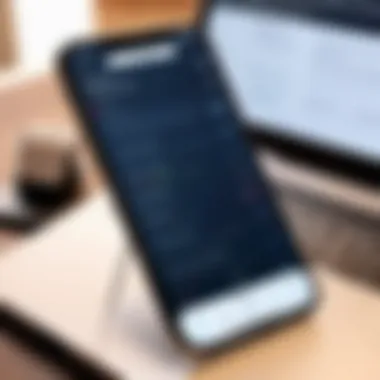
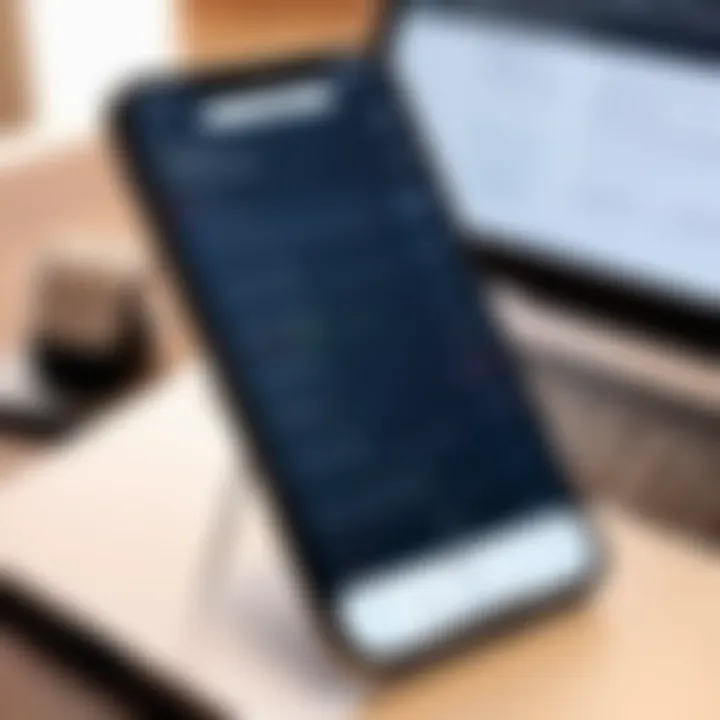
To mitigate these errors, consider the following steps:
- Choose a Quiet Environment: Always attempt to take notes in a setting that minimizes background noise.
- Speak Clearly: Articulate words slowly and distinctly to aid voice recognition accuracy.
- Use Headphones With a Microphone: These can sometimes provide improved audio clarity compared to the built-in microphone.
"Regularly check your microphone and audio settings to ensure optimal performance when taking voice notes."
Connectivity and Software Issues
Connectivity issues can also pose significant challenges when using voice note features. A stable internet connection is often required for optimal performance, especially when using online voice recognition tools. Problems in this area may stem from:
- Weak Wi-Fi Signal: Inadequate signal strength may hinder the device's ability to process voice input.
- Outdated Software: Running an outdated version of iOS can cause compatibility problems, affecting the functionality of voice features.
- App-Specific Glitches: Sometimes, the problem lies within the application itself, which may require an update or a reset to resolve.
To address these matters, follow these recommendations:
- Check Network Status: Ensure your iPhone is connected to a strong network, whether it’s Wi-Fi or cellular data.
- Update iOS and Applications: Regularly install software updates to maintain compatibility and performance.
- Restart the Device: A simple restart can often resolve temporary software glitches and issues.
By understanding and tackling these common issues, users can enhance their experience with voice note-taking on iPhone, ensuring that the technology works seamlessly for their needs.
Privacy and Data Security Concerns
In an age where digital privacy is of utmost importance, understanding how your data is handled when using voice note-taking features on your iPhone is crucial. With the ease and efficiency provided by voice notes, comes the responsibility to ensure that sensitive information remains secure. The nature of voice notes often implies the storage of personal, financial, or professional details, which, if mishandled, can lead to significant risks. Thus, recognizing the privacy implications is essential for every user.
As users leverage voice recognition technology, it becomes necessary to consider how these interactions are processed by the device. Apple emphasizes privacy and data security across its ecosystem. However, it is beneficial for users to become aware of what data may be collected, how it is used, and the implications for their personal security in a digitally connected world.
Understanding Data Handling by Apple
Apple has long championed its commitment to user privacy. When utilizing voice note-taking features, it is important to understand that voice recordings may be processed to improve the service. However, Apple typically anonymizes this data, stripping away identifiable information.
- Voice recordings: When you create a voice note, your iPhone listens to your commands and translates them into text. The way Apple manages this data is designed to minimize any traceable linkage to your identity.
- Usage of your data: Apple may use voice data to enhance features, refine voice recognition algorithms, and improve overall service. However, this typically happens without retaining personal identifiers.
- Data storage: Voice notes are stored locally unless synced with iCloud. Users have control over whether they want these notes to back up online.
"Understanding how technology handles your data is fundamental in maintaining privacy in today's interconnected society."
Although Apple's policies seem robust, users should also take individual measures to safeguard their information.
Best Practices for Safeguarding Voice Notes
To enhance the security of your voice notes, consider the following practices:
- Control iCloud settings: Decide if you want to allow your voice notes to be backed up to iCloud. Disable backups if you are concerned about data stored online.
- Utilize passcodes: Implement a strong passcode or Face ID for your Notes app to prevent unauthorized access.
- Regular updates: Keep your iPhone updated to the latest iOS version to ensure you have the latest security features.
- Be cautious with sensitive information: Avoid noting down critical information like passwords or confidential data in voice notes.
- Check app permissions: Review which applications have access to your microphone and limit them to only those necessary.
These measures can help ensure that your information remains private while you enjoy the convenience of voice note capabilities on your iPhone.
Epilogue
The conclusion draws together all aspects of using voice to write notes on your iPhone. It is crucial as it summarizes the entire article and highlights the significance of each discussed point. Using voice notes can streamline the note-taking process, making it more efficient and less time-consuming. Users can jot down thoughts while driving, walking, or engaging in any other activity that would normally distract from writing.
In addition, it addresses the privacy and security concerns many users may have when utilizing voice recognition technology. Understanding how data is managed by companies like Apple is vital for users who wish to safeguard their personal information.
Lastly, the conclusion touches on future advancements in technology that may further enhance the voice note-taking experience. As voice recognition improves, users can expect a more seamless interaction with their devices, leading to increased productivity and creativity.
Recap of Key Points
- Understanding Voice Notes: Grasping the need for voice notes enhances productivity.
- Setup Requirements: Properly configuring settings is necessary for optimal performance.
- Using Siri: Leveraging Siri for voice notes simplifies the note-taking process.
- Notes App Functionality: Familiarizing oneself with the Notes app is essential for successful note creation and management.
- Exploring Alternatives: Third-party apps offer varied features that can complement or improve the voice note experience.
- Best Practices: Organizing and being clear in notes helps maintain quality and usefulness.
- Troubleshooting: Being equipped with solutions for common issues ensures a smooth experience.
- Data Privacy: Understanding how data is handled is important for security.
By emphasizing these key points, users can find better ways to incorporate voice note-taking into their daily routines.
Future of Voice Note-Taking Technology
Voice note-taking technology continues to evolve. Future advancements are likely to focus on improving accuracy and user experience. Enhanced algorithms will likely lead to better voice recognition, enabling the software to understand context and nuance in speech more effectively.
Also, we can expect integration with artificial intelligence to create smarter applications that not only take notes but also categorize and summarize them intelligently. For instance, AI could analyze patterns in what users dictate and then automatically suggest relevant tags or categories for better organization.
Furthermore, as smart home devices become more prevalent, using voice notes may eventually extend beyond the smartphone. Imagine telling your home assistant to jot down a reminder while you're cooking or running errands. This seamless integration across various devices can significantly enhance the overall efficiency of daily tasks.







